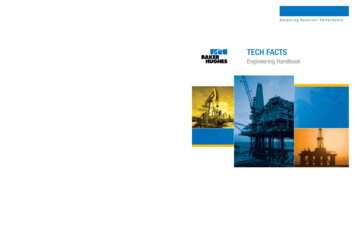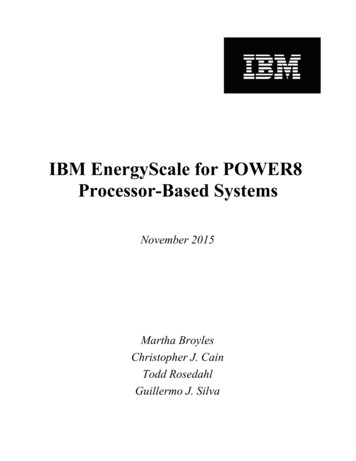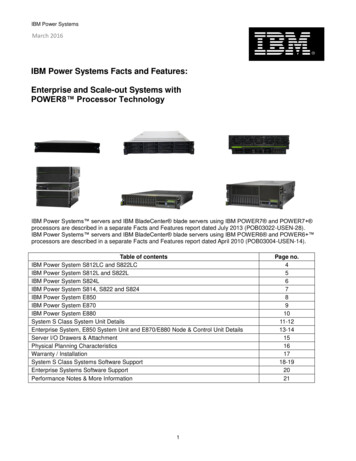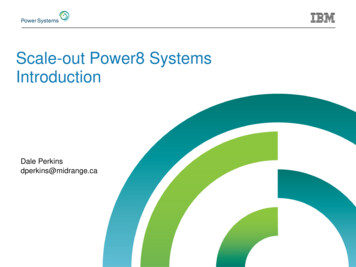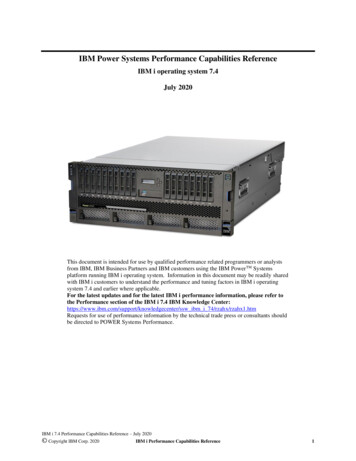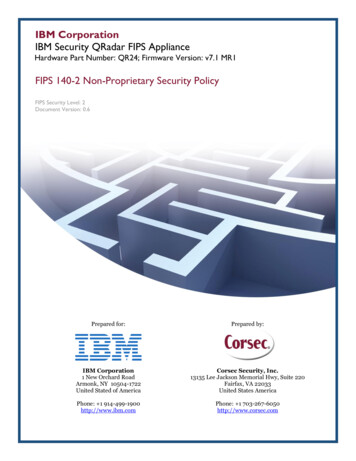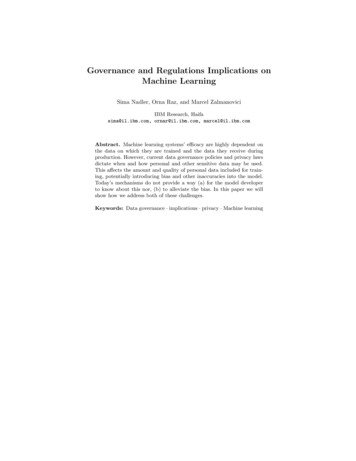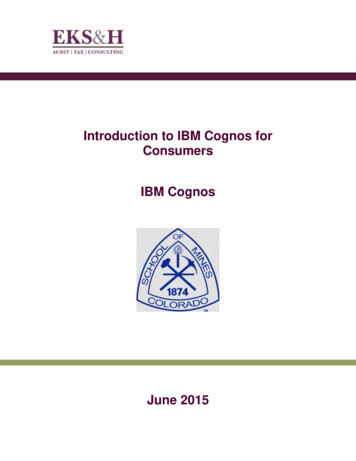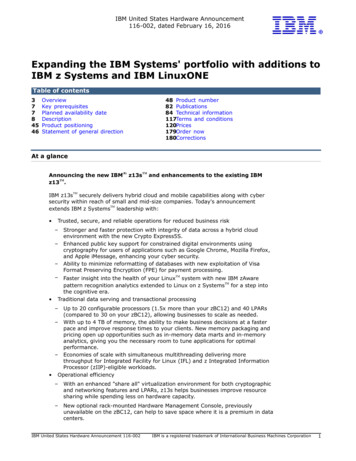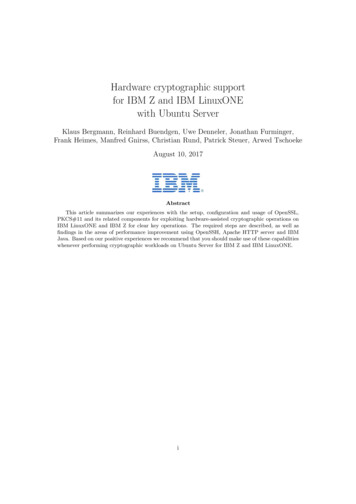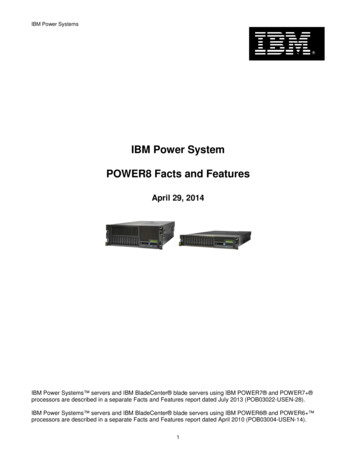
Transcription
IBM Power SystemsIBM Power SystemPOWER8 Facts and FeaturesApril 29, 2014IBM Power Systems servers and IBM BladeCenter blade servers using IBM POWER7 and POWER7 processors are described in a separate Facts and Features report dated July 2013 (POB03022-USEN-28).IBM Power Systems servers and IBM BladeCenter blade servers using IBM POWER6 and POWER6 processors are described in a separate Facts and Features report dated April 2010 (POB03004-USEN-14).1
IBM Power SystemsTable of ContentsIBM Power System S812LIBM Power System S822 and IBM Power System S822LIBM Power System S814 and IBM Power System S824System Unit DetailsServer I/O Drawers & AttachmentPhysical Planning CharacteristicsWarranty / InstallationPower Systems Software SupportPerformance Notes & More Information456789101112These notes apply to the description tables for the pages which follow:YOptionalN/A or SODSLESRHELabcdefg*Standard / SupportedOptionally Available / SupportedNot Available / Supported or Not ApplicableStatement of General Direction announcedSUSE Linux Enterprise ServerRed Hat Enterprise LinuxOne x8 PCIe slots must contain a 4-port 1Gb Ethernet LAN available for client useUse of expanded function storage backplane uses one PCIe slotBackplane provides dual high performance SAS controllers with 1.8 GB write cache expanded up to 7.2 GB withcompression plus Easy Tier function plus two SAS ports for running an EXP24S drawerFull benchmark results are located at ibm.com/systems/power/hardware/reports/system perf.htmlOption is supported on IBM i only through VIOS.For simplicity in calculating maximum and consistently describing the max across the Scale-out Servers, the 12-baybackplane is assumed. A higher max with the expanded function backplane is possible.USB-2 ports have limited client usage. IBM i clients can use a port to communicate with a UPSNot available in PowerKVM environmentFor additional connectivity information, please reference the IBM Sales Manual for more information on I/O features andadapters.2
IBM Power SystemsWhy Power Systems?Powerful forces—mobile, cloud and big data & analytics—are redefining how business getsdone. Leaders are leveraging these forces to deepen relationships with customers andpartners, drive new efficiencies and expand business models. IBM is the right partner to helpyou:Leverage systems that optimize big data and analytics performance.Power Systems are designed for big data—from operational to computational to business andcognitive Watson solutions—are optimized for performance and can scale to supportdemanding and growing workloads. Capitalize on the currency of data by finding businessinsights faster and more efficiently. And gain the elasticity you need to handle the varyinganalytics initiatives your business requires.Realize the true potential of enterprise cloud.Power Systems will help you deliver on the promise of cloud and take advantage of superiorcloud economics. With higher utilization and performance capabilities and the ability to scaleout and up, you can reap the benefits of improved economics associated with fewer scale-outsystems. Leveraging the robust security built into the foundation of Power Systems, you gainthe confidence you need to move more workloads to the cloud, capitalize on greaterefficiencies and do more.Revolutionize the way IT is created and consumed.Power architecture is at the heart of the OpenPOWER Foundation, a community that’s takingadvantage of an open technology platform to help organizations create new opportunities anddesign next-generation applications to drive business success. The first to adopt open servertechnology, Power Systems help you more quickly and easily deliver a broader set of servicesand incorporate new technologies using the same technology footprintFollow us @IBMpowersystemsLearn more at www.ibm.com/power3
IBM Power SystemsPower S812LProduct LineMachine typeSystem packagingMicroprocessor type# of processor sockets per serverProcessor optionsGHz (cores/socket) # of coresEnergyScaleLevel 2 (L2) cache per coreLevel 3 (L3) cache per coreSystem memory (minimum maximum) (1600 MHz DDR3)Active Memory ExpansionReliability, availability,serviceabilityChipkill memoryService processorHot-swappable disks/ SSDDynamic Processor DeallocationProcessor Instruction RetryAlternate Processor RecoveryHot-plug concurrent maintenancePCIe slotsRedundant hot-plug powerRedundant hot-plug coolingNode Add, Node Repair, MemoryUpgradeDual VIOSCapacity and expandabilityCapacity on Demand (CoD)PowerVM PowerLinux EditionPowerKVM EditionPowerVM Standard EditionPowerVM Enterprise EditionMax logical partitions/micro-partitionsSystem unit PCIe Gen3 low profileslots aPCIe expansion I/O drawerSystem unit disk/SSD bays withstandard or split backplaneSystem unit disk/SSD bays withexpanded function backplane anddual IOA with 7.2GB write cache b, cSlimline DVD bayMaximum TB storage in system unitMaximum EXP24S storage drawersMaximum EXP24S SAS baysMaximum total SAS bays (systemunit EXP24S)Max TB storage (system unit EXP24s)PerformancedAIX rPerfGHz (cores/socket): perf (# cores)IBM i CPWGHz (cores/socket): perf (# cores)IBM Power S812L8247-21L19" rack drawer (2U)64-bit POWER813.42 GHz (10) 103.02 GHz (12) 12Y512 KB8 MB16 GB – 512 /AN/A2404 PCIe x82 PCIe x160, but SOD12 SFF-3 or6 6 SFF-38 SFF-3 plus optional EXP24Sattachment for an additional 24SFF-2 bays114.4 TB (with 12x 1.2 TB disks)14336 SFF-2348417 TB using 348x 1.2 TB diskdrivesN/AN/A4
IBM Power SystemsPower S822 and Power S822LProduct LineMachine typeSystem packagingMicroprocessor type# of processor sockets per serverProcessor optionsGHz (cores/socket) # of coresEnergyScaleLevel 2 (L2) cache per coreLevel 3 (L3) cache per coreSystem memory (minimum maximum) (1600 MHz DDR3)Active Memory ExpansionReliability, availability,serviceabilityChipkill memoryService processorHot-swappable disksDynamic Processor DeallocationProcessor Instruction RetryAlternate Processor RecoveryHot-plug concurrent maintenancePCIe slotsRedundant hot-plug powerRedundant hot-plug coolingNode Add, Node Repair, MemoryUpgradeDual VIOSCapacity and expandabilityCapacity on Demand (CoD)PowerVM PowerLinux EditionPowerVM Standard EditionPowerVM Enterprise EditionPowerKVM EditionMax logical partitions/micro-partitionsSystem unit max PCIe Gen3 lowprofile slots oPCIe expansion I/O drawerSystem unit disk/SSD bays withstandard or split backplaneSystem unit disk/SSD bays withexpanded function backplane anddual IOA with 7.2GB write cache andEasy Tier function b, cSlimline DVD bayMaximum TB storage in system unitMaximum EXP24S storage drawersMaximum EXP24S SAS baysMaximum total SAS bays (systemunit EXP24S)Max TB storage (system unit EXP24s)PerformancedAIX rPerfGHz (cores/socket): perf (# cores)IBM i CPWGHz (cores/socket): perf (# cores)IBM Power S8228284-22A19" rack drawer (2U)64-bit POWER823.89 GHz (6) 6 or 123.42 GHz (10) 10 or 20Y512 KB8 MB16 GB – 512 GB (1 DCM)32 GB – 1024 GB (2 DCM)OptionalIBM Power S822L8247-22L19" rack drawer (2U)64-bit POWER823.42 GHz (10) 203.02 GHz (12) 24Y512 KB8 MBYYYYYYYYYY*Y*Y*32 GB -1024 ptionalN/A4005 PCIe x84 PCIe x160, but SOD12 SFF-3 or6 6 SFF-38 SFF-3 plus 6 1.8-inch SSD baysplus optional EXP24S attachmentfor an additional 24 SFF-2 baysN/AOptionalN/AN/AOptional4805 PCIe x84 PCIe x160, but SOD12 SFF-3 or6 6 SFF-38 SFF-3 plus 6 1.8-inch SSD baysplus optional EXP24S attachmentfor an additional 24 SFF-2 bays114.4 TB (with 12x 1.2 TB disks)14336 SFF-2114.4 TB (with 12x 1.2 TB disks)14336 SFF-2348348417 TB using 348x 1.2 TB diskdrives3.89 GHz (6): 120.83.42 GHz (10): 177.83.89 GHz (12): 235.63.42 GHz (20): 346.7417 TB using 348x 1.2 TB diskdrivesN/AN/AN/A5
IBM Power SystemsPower S814 and Power S824Product LineMachine typeSystem packagingMicroprocessor type# of processor sockets per serverIBM Power S8148286-41A19" rack drawer (4U)64-bit POWER81OptionalIBM Power S8248286-42A19" rack drawer (4U)64-bit POWER823.89 GHz (6) 6 or 124.15 GHz (8) 8 or 163.52 GHz (12) 24Y512 KB8 MB32 GB - 512 GB (1 DCM)32 GB – 1024 GB (2 DCM)OptionalProcessor optionsGHz (cores/socket) # of cores3.02 GHz (6) 63.72 GHz (8) OptionalOptional1605 PCIe x82 PCIe x160, but SOD12 SFF-3 or6 6 SFF-318 SFF-3 plus optional EXP24Sattachment for an additional 24SFF-2 bays14336 SFF-2N/AN/AN/AOptionalOptional4807 PCIe x84 PCIe x160, but SOD12 SFF-3 or6 6 SFF-318 SFF-3 plus 8 1.8-inch SSDbays plus optional EXP24Sattachment for an additional 24SFF-2 bays124.7 TB (with 18x 1.2 TB disksplus 8x 387 GB SSD )14336 SFF-2348 f348 fEnergyScaleLevel 2 (L2) cache per coreLevel 3 (L3) cache per coreSystem memory (minimum maximum) (1600 MHz DDR3)Active Memory ExpansionReliability, availability,serviceabilityChipkill memoryService processorHot-swappable disksDynamic Processor DeallocationProcessor Instruction RetryAlternate Processor RecoveryHot-plug concurrent maintenancePCIe slotsRedundant hot-plug powerRedundant hot-plug coolingNode Add, Node Repair, MemoryUpgradeDual VIOSCapacity and expandabilityCapacity on Demand (CoD)PowerVM PowerLinux EditionPowerKVM EditionPowerVM Standard EditionPowerVM Enterprise EditionMax logical partitions/micro-partitionsSystem unit PCIe Gen3 full highslots aPCIe expansion I/O drawerSystem unit disk/SSD bays withstandard or split backplaneSystem unit disk/SSD bays withexpanded function backplane anddual IOA with 7.2GB write cache b, cY512 KB8 MBSlimline DVD bayMaximum TB storage in system unit121.6 TB (with 18x 1.2 TB disks )Maximum EXP24S storage drawersMaximum EXP24S SAS baysMaximum total SAS bays (systemunit EXP24S) fMax TB storage (system unit EXP24s) fPerformanced16 GB – 512 GB417 TB using 348x 1.2 TB diskdrives fAIX rPerfGHz (cores/socket): perf (# cores)3.02 GHz (6): 97.53.72 GHz (8): 143.9IBM i CPWGHz (cores/socket): perf (# cores)3.02 GHz (6): 59,5003.72 GHz (8): 85,500417 TB using 348x 1.2 TB diskdrives f3.89 GHz (6) : 120.84.15 GHz (8) : 1663.89 GHz (12) : 235.64.15 GHz (16) : 323.63.52 GHz (24) : 421.93.89 GHz (6) : 72,0004.15 GHz (8) : 94,5003.89 GHz (12) : 130,0004.15 GHz (16) : 173,5003.52 GHz (24) : 230,5006
IBM Power SystemsSystem Unit Details (Power Systems S Class Servers )System Unit DetailsPOWER8 DCM socketsNumber of DCMsMax memory DIMM slotsMax memory bandwidthIntegrated portsSystem/serial (RJ45)gUSB-2 portsUSB-3 portsHMC ports (RJ45)aEthernet adapter portsSAS bays in system unit2.5-inch (disk/SSD)1.8-inch (SSD)Media baysDVD-RAM slimlineHH for tapeIntegrated SAS storagecontrollers fordisk/SSD/DVDBase backplaneSplit backplaneExpanded functionb, cbackplaneEasy Tier functionOptional EXP24S portsPCIe Gen3 adapter slotsPCIe x8PCIe x16Max PCIe bus speed(GHz)Max I/O bandwidthLED diagnostics8192 GB/secPower S822Power S822L21 or 2 for S8222 for S822L16 (with 2 DCM)384 GB/sec124 (2 front & 2 rear)24x 1Gb124 (2 front & 2 rear)24x 1Gb124 (2 front & 2 rear)24x 1Gb124 (2 front & 2 rear)24x 1Gb12 or 8 SFF-3012 or 8 SFF-30 or 612 or 18 SFF-3012 or 18 SFF-30 or 81N/A1N/A1N/A1N/AYYYY1 (zero write cache)2 (zero write cache)Dual IOA (7.2 GBwrite cache) b, cY with expandedfunction backplaneY with expandedfunction backplane6421 (zero write cache)2 (zero write cache)Dual IOA (7.2 GBwrite cache) b, cY with expandedfunction backplaneY with expandedfunction backplane9 (w/ 2 DCM)541 (zero write cache)2 (zero write cache)Dual IOA (7.2 GBwrite cache) b, cY with expandedfunction backplaneY with expandedfunction backplane7521 (zero write cache)2 (zero write cache)Dual IOA (7.2 GBwrite cache) b, cY with expandedfunction backplaneY with expandedfunction backplane11 (w/ 2 DCM)7410.0 (Gen3)10.0 (Gen3)10.0 (Gen3)10.0 (Gen3)96 GB/secY96 GB/sec per DCMY96 GB/secY96 GB/sec per DCMYPower S812L11Power S814Power S8241211 or 28192 GB/sec16 (with 2 DCM)384 GB/secStorage backplane notes: Integrated SAS controllers are based on latest IBM patented SAS RAID adapter technology. Allbackplane options offer RAID 0, 1, 5, 6, 10 capabilities plus hot spare capability. Write cache is mirrored for protection andphysically is two 1.8 GB DRAM caches offering up to 7.2 GB effective capacity with compression. One optional EXP24Sstorage drawer attachment is to two SAS ports on rear of server which are provided with the expanded function backplane.The EXP24S is external to the system unit taking 2U rack space and attached via SAS cables and provides 24 SSF-2 SASbays for disk or for SSD.7
IBM Power SystemsServer I/O DrawersDrawerEXP24S (#5887 /#EL1S)PCIe Gen3 I/ODrawerServerAttachmentPCI Slots perDrawerBays perDrawerAvailable toorderMaxDrawersper serverDrawerFootprintvia SAS024 SFF-2 SASY1419” rack 2UN/ASODN/ASODN/AN/AServer I/O Drawer 2LPowerS814PowerS824EXP24SMax 14Max 14Max 14Max 148
IBM Power SystemsPhysical Planning Characteristics (Power System S Class Servers)Note: More comprehensive information may be found in the IBM Site and Hardware Planning document 8/p8hdx/POWER8welcome.htm . Plus, additional summary informationcan be found in the IBM Sales Manual for each server at ibm.com/common/ssi . Note the knowledgecenter document may notbe available until Mid May, 2014.ServerPackagingVoltage (AC)single phasePower supplyMaximum altitudefeetmetersRacksPower S812L19" rack drawer (2U)Power S822Power S822LPower S82419" rack drawer(4U)100003048100 -127200 - 240200 – 240N 1 standardN 1 standard19" rack drawer (4U) TowerTower: 100-127200-240Rack: 200 - 240N 1 standard1000030481000030481000030487014-S25 or#055525U19" rack drawer(2U)Power S8147014-T00 or#055136UHeightinches49.071.0 – 75.8millimeters13441804 – 1926Width (can vary depending on use of side panels)inches23.824.5 – 25.4millimeters605623 – 644Depth (can vary depending on door options selected)inches39.441.0 – 45.2millimeters10011042 – 10989200 - 240N 1 standard7014-T42 or#055342U7014-B4242U7965-94YSlim Rack42U79.3201579.3201578.8200224.5 - 25.4623 - 64424.5 - 25.4623 - 64423.660041.0 - 45.21043 - 109841.0 - 55.51042 - 140943.1 – 48.21095 - 1224
IBM Power SystemsWarranty1 / InstallationWarranty ServiceLevels24x7 with two hour2service objective24x7 with four hourservice objective9x5 with four hourservice objective9x5 next-businessdayWarranty Period4Server installPowerS812LPower S822Power S814 Power S824Power lStandard3 yearsCSU3Standard3 yearsCSU3Standard3Standard3 yearsCSU33 yearsCSU1. These warranty terms and conditions are for the United States and may be different in other countries. Consult your localIBM representative or IBM Business Partner for country-specific information.2. Available in selected cities.3. Mandatory Customer Replaceable Unit (CRU) and On-site service.4. CSU Customer Set Up, IBI Installation by IBM For server hardware only. Note except for 795 I/O, feature I/Odrawers added later as MES are CSU.10
IBM Power SystemsPower S Class Servers Software SupportPower Systems SoftwareSoftware TierPower S812L Power S822 Power S822L Power S814SmallSmallPower portedN/ASupportedN/AAIX 6.1 *N/ASupportedN/ASupportedSupportedAIX 7.1 *N/ASupportedN/ASupportedSupportedIBM i Software TierN/AN/AN/ASmall P10 3Small P20 3IBM i 7.1 TR8 *N/AN/AN/ASupportedSupportedIBM i 7.2 *N/AN/AN/ASupportedSupportedRed Hat EnterpriseLinux 6.5 *SupportedSupportedSupportedSupportedSupported 4,5SUSE Linux Enterprise Server 11 upported 4,5SP1Ubuntu werHA SystemMirror for i 6.1N/AN/AN/ASupportedSupportedPowerHA SystemMirror for i 7.1 Standardand Enterprise EditionsN/AN/AN/ASupportedSupportedPowerVM PowerVM Linux EditionPowerVM ExpressPowerVM Standard and Enterprise EditionsPowerKVMAIXIBM iLinuxPowerHA PowerHA SystemMirror for AIX 6.12 Standardand Enterprise EditionsPowerHA SystemMirror for AIX 72 StandardEdition* Or later version1 – Note that AIX 6.1 and AIX 7.1 Express Edition may be used for partitions of up to 4 cores and 8 GB of memory per core.2 – PowerHA SystemMirror for AIX 6.1 is supported on AIX 5.3,AIX 6.1 and AIX 7.1. PowerHA SystemMirror for AIX 7 is supported with bothAIX 6.1 and AIX 7.13 – P10 requireds user entitlements and includes 5250 Enterprise Enablement capability. P20 does not have user entitlements and 5250Enterprise Enablement is ordered as an optional hardware feature code.11
IBM Power SystemsPerformance NotesThe performance information contained herein is current as of the date of this document. All performancebenchmark values and estimates are provided “AS IS” and no warranties or guarantees are expressed or impliedby IBM. Buyers should consult other sources of information, including system benchmarks, to evaluate theperformance of a system they are considering.rPerf (Relative Performance) is an estimate of commercial processing performance relative to other IBM UNIX systems. It is derived from an IBM analytical model which uses characteristics from IBM internal workloads, TPCand SPEC benchmarks. The rPerf model is not intended to represent any specific public benchmark results andshould not be reasonably used in that way. The model simulates some of the system operations such as CPU,cache and memory. However, the model does not simulate disk or network I/O operations.rPerf estimates are calculated based on systems with the latest levels of AIX and other pertinent software at thetime of system announcement. Actual performance will vary based on application and configuration specifics. TheIBM eServer pSeries 640 is the baseline reference system and has a value of 1.0. Although rPerf may beused to approximate relative IBM UNIX commercial processing performance, actual system performance mayvary and is dependent upon many factors including system hardware configuration and software design andconfiguration. Variations in incremental system performance may be observed in commercial workloads due tochanges in the underlying system architecture. For additional information about rPerf, contact your localIBM office or IBM authorized reseller.Commercial Processing Workload (CPW) is a relative measure of performance of systems running the IBM i operating system.Performance in client environments may vary. The value is based on maximum configurations. For a complete descriptionPlease refer to the “IBM Power Systems Performance Capabilities Reference - IBM i operating system” at the following Website of CPW and the CPW rating for IBM Power ement/performance/resources.htmlAll performance estimates are provided “AS IS” and no warranties or guarantees are expressed or implied byIBM. Buyers should consult other sources of information, including system benchmarks and application sizingguides to evaluate the performance of a system they are considering buying. Actual system performance mayvary and is dependent upon many factors including system hardware configuration and software design andconfiguration. IBM recommends application-oriented testing for performance predictions. Additional informationabout the performance benchmarks, values and systems tested is available from your IBM marketingrepresentative or IBM Authorized Reseller or access the following on the Web:SPEC – http://www.spec.orgTPC – http://www.tpc.orgMore information Contact your IBM sales representative or IBM Business PartnerAccess the Power Systems Products and Services page on IBM’s World Wide Web server atibm.com/systems/power and then select the appropriate hardware or software optionProduct announcement letters and Sales Manual containing more details on hardware an
IBM Power System S822 and IBM Power System S822L 5 IBM Power System S814 and IBM Power System S824 6 System Unit Details 7 Server I/O Drawers & Attachment 8 Physical Planning Characteristics 9 Warranty / Installation 10 Power Systems Software S
